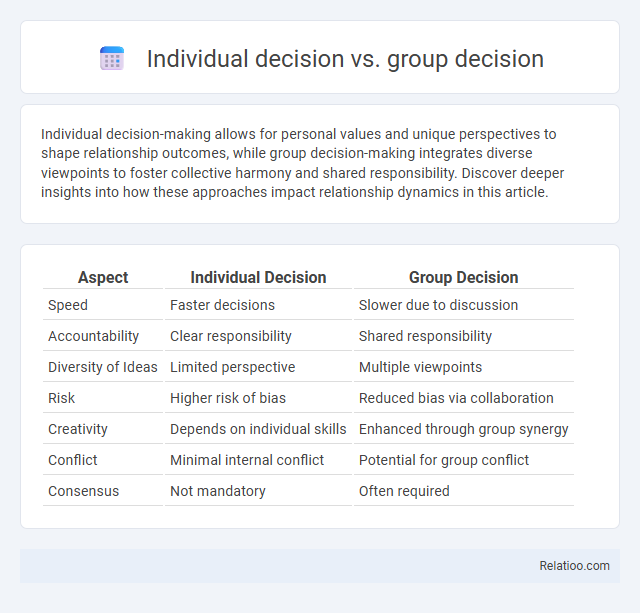Individual decision-making allows for personal values and unique perspectives to shape relationship outcomes, while group decision-making integrates diverse viewpoints to foster collective harmony and shared responsibility. Discover deeper insights into how these approaches impact relationship dynamics in this article.
Table of Comparison
| Aspect | Individual Decision | Group Decision |
|---|---|---|
| Speed | Faster decisions | Slower due to discussion |
| Accountability | Clear responsibility | Shared responsibility |
| Diversity of Ideas | Limited perspective | Multiple viewpoints |
| Risk | Higher risk of bias | Reduced bias via collaboration |
| Creativity | Depends on individual skills | Enhanced through group synergy |
| Conflict | Minimal internal conflict | Potential for group conflict |
| Consensus | Not mandatory | Often required |
Understanding Individual Decision Making
Understanding individual decision making involves analyzing how personal values, cognitive biases, and emotions influence your choices without external input. Unlike group decisions, which often require consensus and can be impacted by social dynamics like groupthink, individual decisions are shaped solely by one's internal reasoning processes. Recognizing these factors enhances your ability to make clear, confident judgments while avoiding dilemmas that arise from conflicting group interests.
Exploring Group Decision Making
Group decision-making harnesses diverse perspectives, promoting comprehensive solutions by integrating multiple viewpoints and expertise. This collaborative process often enhances creativity and risk assessment, reducing individual bias and improving decision quality. However, challenges such as groupthink and social pressure may hinder optimal outcomes, necessitating structured communication and clear roles to maximize group effectiveness.
Key Differences Between Individual and Group Decisions
Individual decisions are typically faster and reflect personal experiences, preferences, and cognitive biases, whereas group decisions incorporate diverse perspectives and collective knowledge, enhancing creativity but often slowing the process. Group decisions can lead to phenomena like groupthink, where conformity pressures suppress dissenting opinions, contrasting with an individual's autonomous risk assessment. Dilemmas arise when both individual and group choices involve conflicting values or uncertain outcomes, requiring careful evaluation of trade-offs in responsibility and accountability.
Advantages of Individual Decision Making
Individual decision-making allows for quicker resolutions by eliminating the need for consensus, which is especially beneficial in time-sensitive situations. It leverages personal expertise and accountability, leading to clear ownership of outcomes and streamlined implementation. This approach reduces the potential for groupthink, ensuring decisions are based on unique perspectives and unbiased judgment.
Benefits of Group Decision Making
Group decision making leverages diverse perspectives and expertise, resulting in more comprehensive and well-rounded solutions compared to individual decision making. Collaborative efforts enhance creativity, reduce biases, and improve the quality of decisions by incorporating multiple viewpoints. This collective approach often leads to greater commitment and accountability among participants, increasing the likelihood of successful implementation.
Common Challenges in Individual Choices
Individual decisions often face challenges such as cognitive biases, limited information, and emotional influences that can distort rational judgment. Your choices may suffer from overconfidence, confirmation bias, or analysis paralysis, leading to suboptimal outcomes. In contrast, group decisions can mitigate some individual errors but introduce complexity like groupthink and conflicts, while dilemmas present conflicting values that complicate any singular choice.
Pitfalls of Group Decision Processes
Group decision processes often suffer from pitfalls such as groupthink, where the desire for consensus overrides critical evaluation, leading to poor outcomes. Social pressures and dominant personalities can suppress dissenting opinions, reducing the diversity of perspectives essential for robust decisions. Miscommunication and diffusion of responsibility further exacerbate errors, making group decisions less reliable compared to individual judgments.
Factors Influencing Decision Effectiveness
Factors influencing decision effectiveness vary between individual and group contexts, with cognitive biases and personal experience playing a significant role in individual decisions. Group decisions benefit from diverse perspectives and collective knowledge but are often challenged by groupthink and social conformity pressures. Decision dilemmas arise when conflicting values or incomplete information impede clear choices, making clarity of objectives and communication critical for effective outcomes.
When to Choose Individual vs Group Decisions
Individual decisions are optimal when quick, autonomous choices are needed, and the decision-maker has sufficient expertise or information, reducing delays and potential conflicts. Group decisions are preferable in complex situations requiring diverse perspectives, collaboration, and shared responsibility to enhance creativity and commitment. In dilemma contexts, weighing the benefits of individual insight against group consensus helps determine the decision-making approach that balances efficiency with inclusivity.
Real-World Examples of Decision-Making Approaches
Individual decision-making in high-stakes fields like medicine often demands rapid, autonomous choices, exemplified by an emergency room doctor prioritizing treatments during a critical surgery. Group decision-making processes, such as corporate board meetings, leverage diverse expertise and consensus to navigate complex business challenges, ensuring balanced and strategic outcomes. Your understanding of dilemmas, exemplified by governments weighing economic growth against environmental protection, highlights how competing priorities require careful evaluation and ethical considerations to reach effective solutions.

Infographic: Individual decision vs Group decision
 relatioo.com
relatioo.com